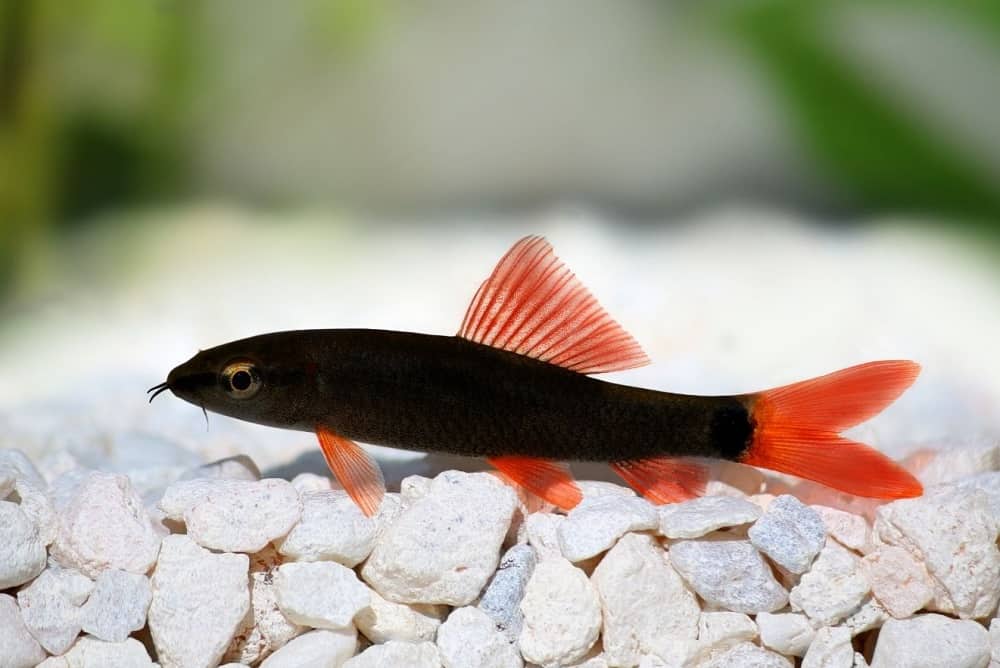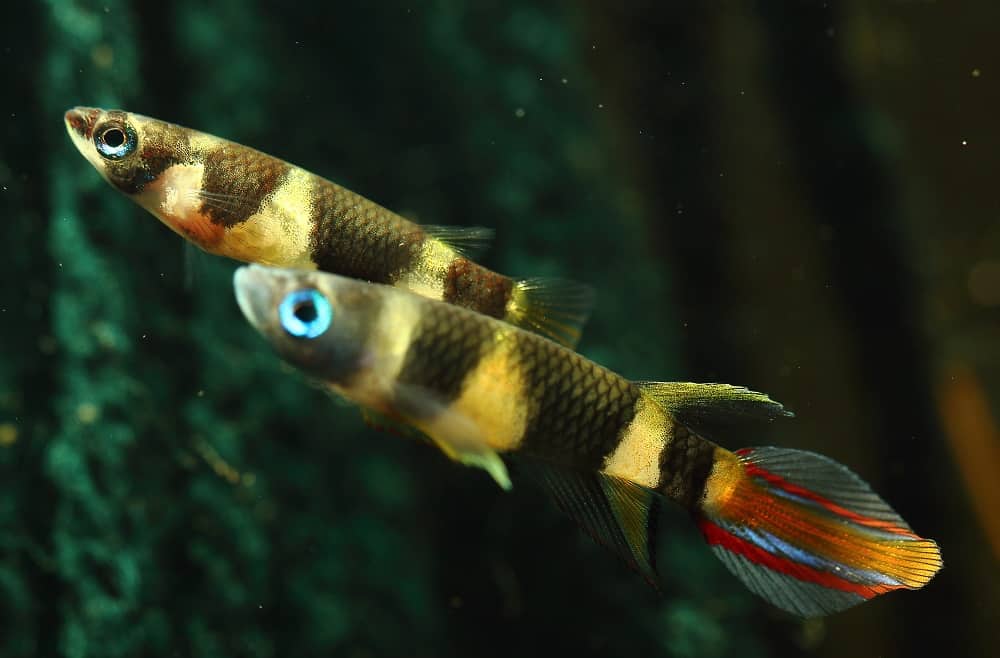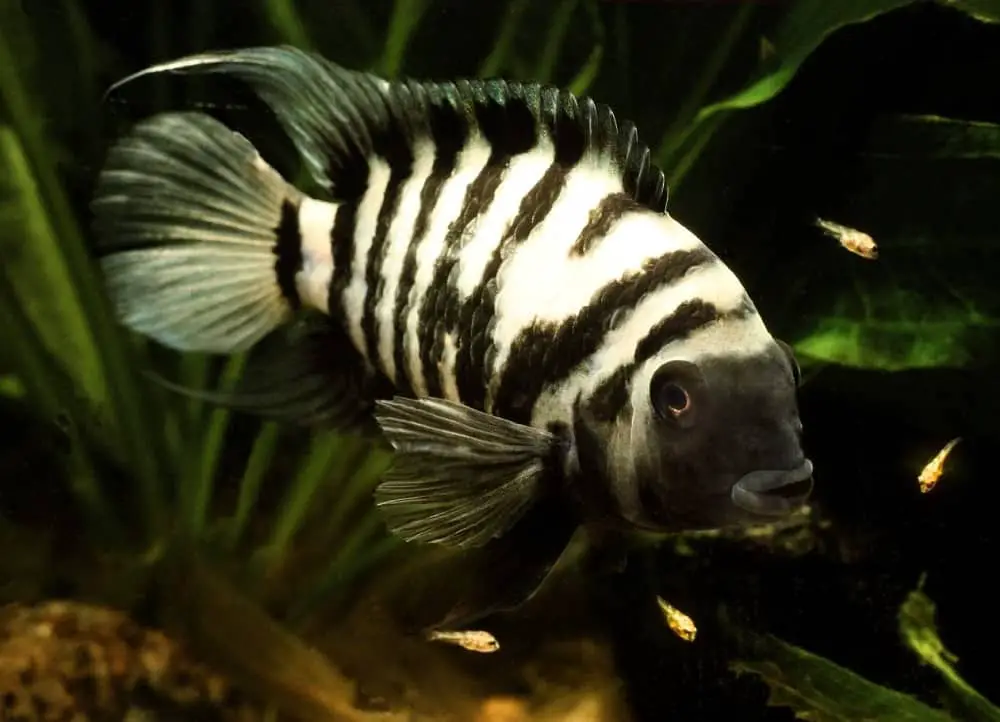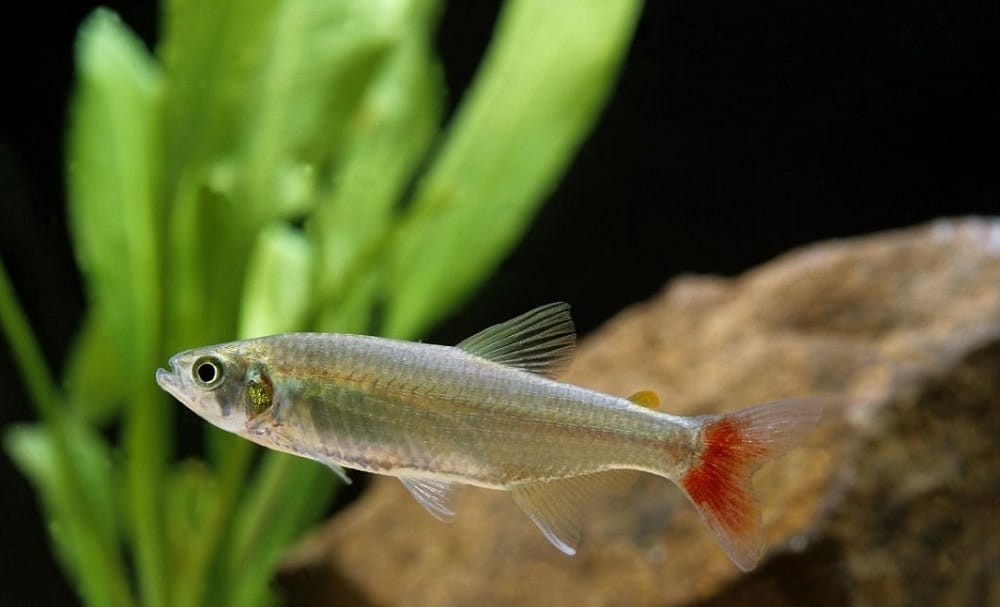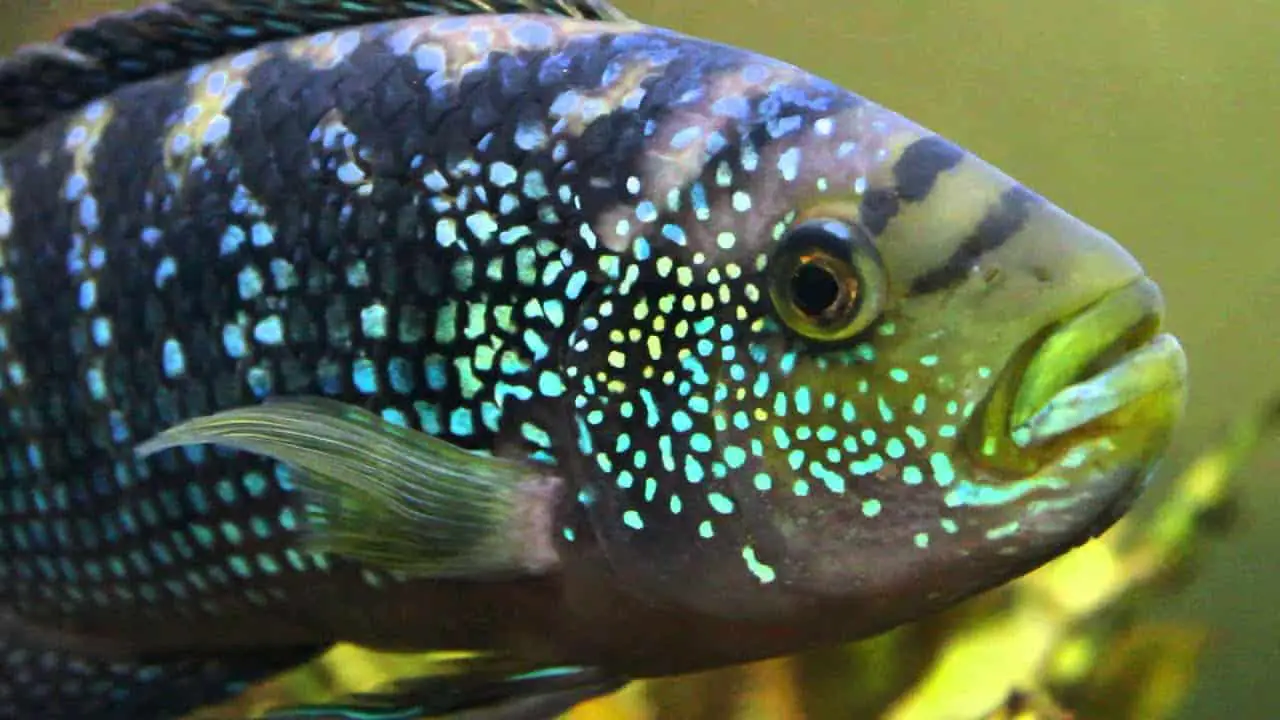Native to the vast and sprawling rivers of Southeast Asia, the iridescent shark is known by many names, a lot of which include “shark”, yet this is something of a misnomer, as they are, in fact, catfish.
Their binomial name is Pangasianodon Hypophthalmus, and they’re part of the catfish family, Pangasiidae. The only reason they’re sometimes referred to as sharks is that they have a shark-like appearance, but that’s where the similarities end.
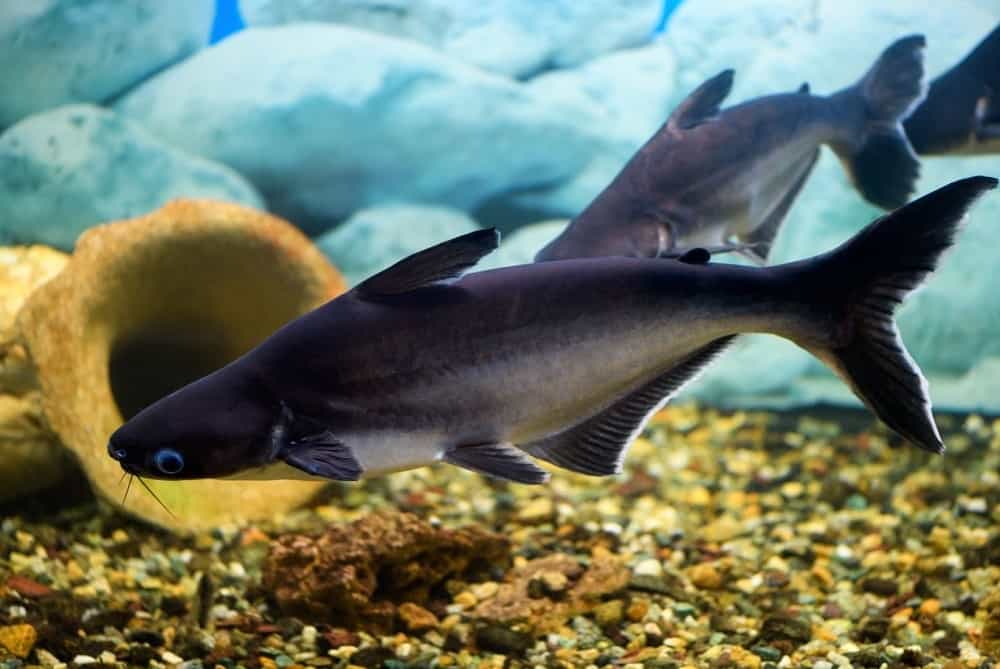
The “iridescence” part of their name, on the other hand, is right on the money, as the skin of juveniles exhibits an opalescent glow, which is part of the reason they’ve become so popular among fish-keeping hobbyists.
Once they reach maturity, their mystical shimmer fades away, revealing a dull, shark-gray.
Care Guide
If you’re thinking about introducing an iridescent shark to your aquatic ecosystem, there are tons of things you need to know in order to prepare.
Tank Size
Due to their size, iridescent sharks can pose a challenge to even the most experienced aquarist. A lot of people simply don’t have the space to accommodate an appropriately-sized tank.
To bring one of these amazing fish into the fold, you’ll need a 100-gallon aquarium at the very least, and that’s just for a juvenile. At some point, you’ll need to upgrade to a 300-gallon tank to accommodate a mature iridescent shark, and even then, its growth may be stunted.
But it’s not just their sheer size that’s the problem. They also have terrible eyesight and may mistake movement outside their tank as a threat, attempt to flee, and injure themselves when they collide with the aquarium wall.
For an adult iridescent shark to thrive as it would in the wild, you should be looking for tanks upwards of 12 meters long, and you’ll need to size-up by 150 gallons with every iridescent shark you acquire. Ideally, you wouldn’t keep them in an aquarium of any description, but a vast, heated pond.
Tank Mates
Iridescent sharks are consummate schooling fish, so if you’re interested in bringing one into your home, for it to be happy and healthy, you’ll need to invite some of its friends over too!
Of course, the more iridescent sharks you own, the bigger your aquarium needs to be, so I hope you’ve got some serious open-plan architecture going on in your home.
The important thing to remember when pairing other species of fish with iridescent sharks is that they’re omnivorous, which means any smaller fish you introduce them to will likely end up as food rather than friends. Crustaceans will also end up on the menu.
In light of this, sticking to larger fish with peaceful dispositions is essential, but again, you’re going to need a huge amount of space to accommodate such a burly bunch. Some fish known to pair well with iridescent sharks include…
- Pearsei
- Black Shark
- Tinfoil Barbs
- Silver Dollars
- Plecostomus
- Kissing Gourami
- Oscer
- Bichir
- Synodontis Catfish
- Texas Cichlid
- Salvin’s Cichlid
- Fire Eel
- Leptobotia elongata loach
…and remember to observe new members of the fishy family closely when first introduced to the aquarium. Any aggressive members will have to be removed from the family unit. As such, it’s best to check with the pet store if they accept refunds or offer credit for returns before purchasing your catfish a friend.
Same Species Tanks
Juvenile iridescent sharks are exceedingly active and social creatures that love hanging out with their own, so it’s a fantastic idea to raise them in schools of 4 to 5.
Water Parameters
Okay, so here’s where things get a little easier. Iridescent sharks are tough cookies, which means that the water parameters of their habitat aren’t necessarily strict. Let’s take a look.
- Temperature: 72 – 79° F (22.2 – 26.1° C)
- pH: 6.5 – 7.5
- Water Hardness: 2 – 20 dGH
Not so bad, huh? But do bear in mind that it takes longer to adjust the water parameters in larger tanks, which means you’ll have to monitor the water closely in order to nip any issues in the bud.
What to Put in Their Tank
Iridescent sharks are big on minimalism, so it’s important to take a less-is-more approach to tank decoration. The goal is to make them feel at home by mimicking their natural habitat as closely as possible.
Don’t worry if you’ve never taken a dip in a deep Southeast Asian river. All you need to know is that there are quite a few rocks and pieces of driftwood on the riverbeds, so that’s what you should source for your aquarium.
It’s essential that you only place furnishings in the base of the tank, making sure there’s plenty of room to swim above. Furthermore, you should keep tank decor sparse, so you don’t limit their lateral freedom of movement.
Don’t worry about introducing any vegetation, as they won’t gain anything from it. Tall plants in particular need to be avoided as they’ll become unnecessary obstacles.
Common Diseases
Fortunately, iridescent sharks aren’t genetically predisposed to any diseases, but their lack of scales does leave them susceptible to certain skin conditions, the most common of which is Ich.
Ich is a parasitic disease that manifests as white spots on a fish. Luckily, it’s incredibly easy to spot on the large gray body of an iridescent shark, so you’ll be able to treat it in its early stages.
Of course, prevention is always better than the cure, so try your hardest to keep your water in tip-top condition, and you may never have to worry about Ich at all.
Food and Diet
As I’ve already touched upon, iridescent sharks are omnivores, so they can eat a variety of weird and wonderful things — they’re not picky. The trick here is to keep dinner time exciting, as they will tire quickly of the same snacks day in and day out.
The only issue is that the more variety you introduce to their diet, the harder it becomes to keep track of the nutrients they’re getting. You’ll have to map out winning chow combinations that provide all the vitamins and minerals they need to grow big and strong.
You can still use flakes as the core of their diet, but it’s also a good idea to augment it with some squirmy living snacks too, as it creates more of a natural environment and enriches their lives. Some of their favorites include…
- Worms
- Brine Shrimp
- Feeder Fish
- Bloodworms
…But whatever treats you give to your iridescent shark, always buy from a reputable brand and make sure they’re of the highest quality. Poor food is the quickest way to introduce nasty bacteria to your aquarium.
If you can’t source live food, you can purchase freeze dried versions to hold them over until you can.
Lifespan
In optimal conditions, an iridescent shark can live to the ripe old age of 20, but that figure plummets when they’re kept in cramped environments and subjected to an improper care routine.
Appearance
One of the most prominent distinguishing characteristics of the iridescent shark is the sail-shaped dorsal fin that will fan out in full-blown shark mode, or tuck away neatly depending on what they’re trying to do.
In place of scales, they have gray skin similar to that of a shark, but when they’re young, their skin glimmers with a brilliant iridescence, which is, of course, where they get their name.
Prominent barbels give them that quintessential, whiskery catfish look, helping them to navigate the deep, dark river waters of Southeast Asia.
Their eyes are quite bulbous, which is strange considering how poor their vision is, but the larger they get, the less prominent their eyes seem.
With sizable, shark-like caudal fins, they’re agile in the water, and their long anal fins (no laughing, guys) run from about halfway up their stomach to the start of the caudal fin.
You may also stumble across the rare albino iridescent shark with snow-white skin and blood-red eyes.
Size
Conditions permitting, an iridescent shark will grow to around 3-4 feet in length, so just under and just over a meter respectively — one hell of a fish, right?
They seem quite small as juveniles, which can give prospective aquarists the wrong idea, inevitably leading to space issues when this catfish hulks out on them.
Behavior and Temperament
Iridescent sharks are some chill fish, rarely exhibiting aggressive behavior, but they scare easily, especially when they’re on their own, which is another reason you should raise them in schools. It’s the whole safety in numbers thing. It emboldens them just enough to relax.
Breeding
If you had visions of breeding your iridescent shark and creating lots of shiny little fish babies, I’ve got some bad news for you. These fish only breed in the wild.
It’s largely due to their being migratory fish. Their breeding instincts fire up once they’ve completed their pilgrimage upstream to deeper waters. In the absence of such a journey, reproduction simply won’t be on their agenda.
Gender Differences: Male Vs Female
The size and shape of iridescent sharks is pretty much the only way to distinguish their sex, as the females are a tad wider than the males.
Fun Facts
- Iridescent sharks aren’t sharks at all; they’re catfish.
- They migrate upstream to breed in deep water, then return downstream to rear their young in shallower water.
- It’s not such a fun fact, but they’re classed as an endangered species by the IUCN conservation scale. Their waning numbers are mostly due to their being hunted by humans for food.
- Unlike most other catfish, iridescent sharks are diurnal, rather than nocturnal, creatures.

